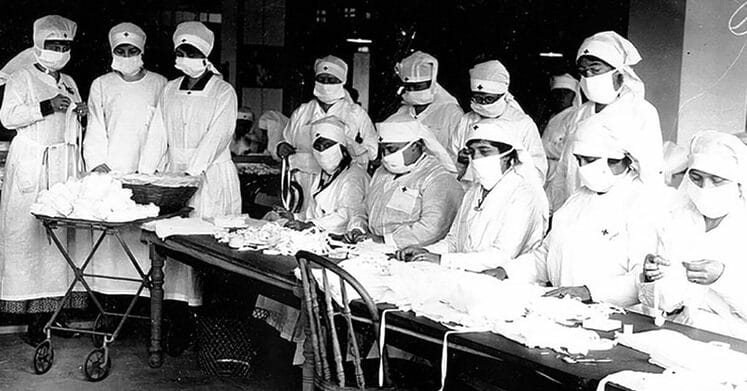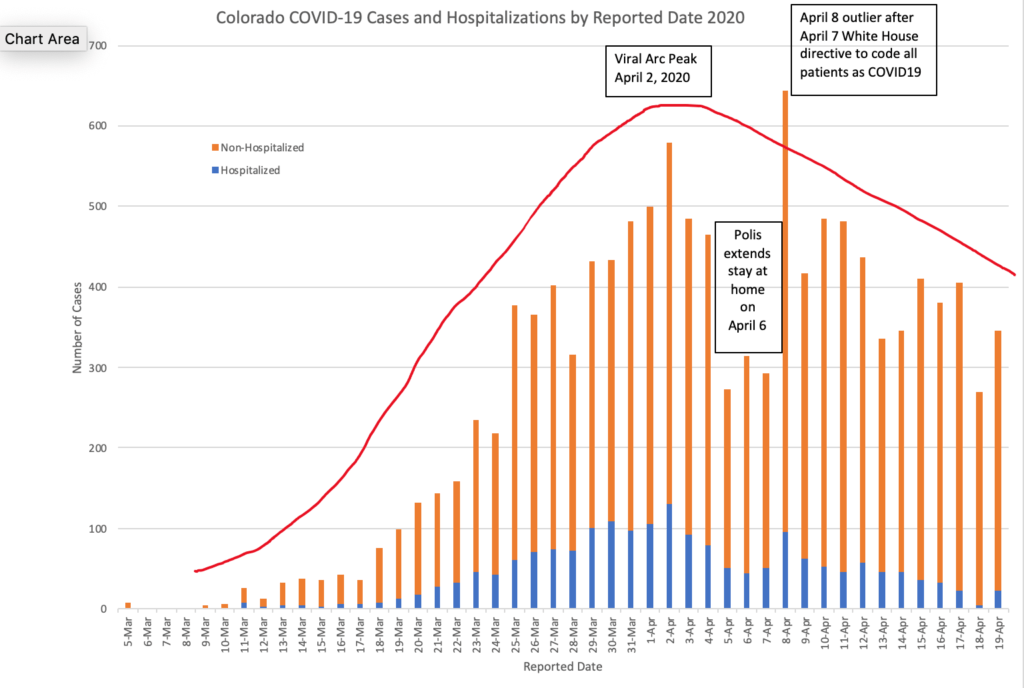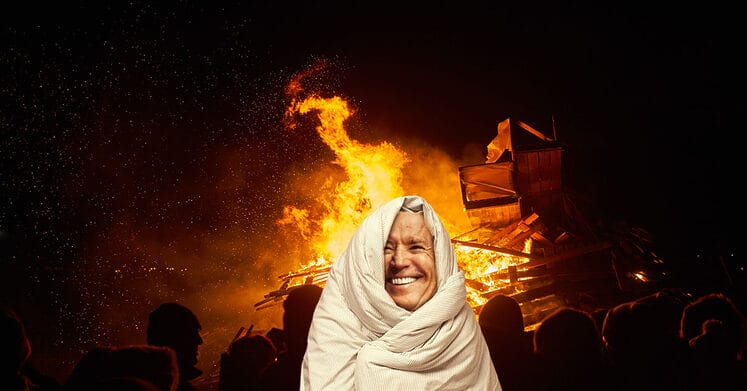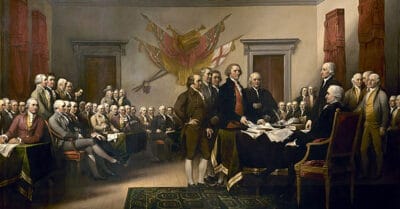The Trend Data
This is an update to my first Colorado COVID data analysis on April 13, 2020 “Colorado COVID-19 Data Indicates Viral Arc Peak Passed on April 3, 2020.” By charting Colorado’s state health department’s CDPHE COVID-19 Case Data in a trend graph, rather than a cumulative graph, the current data shows that COVID19 is in decline in Colorado. In contrast, Governor Polis refers to this decline as a “plateau,” and mentioned a potential for a second wave like the 1918 Influenza Pandemic.
1918-1919 Influenza Pandemic (up to 50 million deaths worldwide)
The research urges health departments to plan for worst-case scenarios based on the 1918 Influenza Pandemic that originated in Army camps and spread to civilians.[i] The main lesson learned is that the first wave in the spring provided cross protection for the second wave in the fall.
“Exposure to influenza in the spring and summer of 1918 provided mortality and morbidity protection during the fall pandemic wave. The intensity of the first wave may have differed across US cities and countries and may partly explain geographical variation in pandemic mortality rates in the fall. Pandemic preparedness plans should consider that immune protection could be naturally acquired during a first wave of mild influenza illnesses.”[ii]
The secondary lesson was that contracting the illness in the first wave provided very high protection in the second wave against both infection and death. “Based on repeated illness data, the first wave provided 35%–94% protection against clinical illness during the second wave and 56%–89% protection against death (P < .001).”[iii] The third lesson, but most critical consideration, was that the second wave in the fall was more fatal than the first wave in the prior spring. The fatality rate was 1.1% among hospitalized soldiers in the first wave, and 4.7% among hospitalized soldiers in the second wave.
The dire warning to heed in this research is found in this statement: “If indeed a mild first wave is documented, the benefits of cross-protection during future waves should be considered before implementing public health interventions designed to limit exposure.”[iv]
In 1918, during the first wave, “illness rates were high, but death rates in most locales were not appreciably above normal. A second or fall wave spread globally from September to November 1918 and was highly fatal”[v] among healthy young adults, aged 20 to 40, sometimes within 24 hours of infection. Historically, the curve of influenza deaths by age has a U-shape with mortality peaks in infants and the elderly. However, the second wave of 1918 exhibited an unprecedented W-shape, with a distinct middle-aged mortality peak in adults.
If I were advising the Governor, I would present two scenarios. The Decline Scenario, based on current data, indicates that the virus in decline and urgently necessitates that “social distancing” must end to save the economy. 200,000 people have already filed for unemployment which will result in thousands of deaths of despair. The Plateau Scenario, or worst-case scenario, provides caution for a potential second wave, and also urgently necessitates that “social distancing” must end to allow maximum people to gain natural immunity through exposure prior to the more fatal second wave.
Recommendations
- Colorado policymakers, public health experts, and scientists must stop the promotion of “social distancing” immediately. The general public should be encouraged to seek the benefits of natural acquired immunity, while the elderly and those with serious existing health conditions should be informed of risks (short term and long term) and given employment accommodations to self-isolate by choice.
- May, June, & July 2020. Public health experts should educate the public on proven ways to increase baseline health and immune function through nutrition and vitamin supplementation, specifically Vitamins A, C, and D.
- Before September 2020. State leaders must make established, effective treatments for Coronavirus widely available now as an over-the-counter transaction, and prepare for increased demand in the fall of 2020, which includes Chloroquine[vi] and Zinc[vii].
- Before September 2020. State leaders must analyze the treatment protocols that did not have life-saving outcomes, specifically comparing ventilation with pressure to providing oxygen without pressure.
- Before September 2020. State leaders must investigate alternative medications that showed therapeutic value for patients such as nebulized iodine and hydrogen peroxide, and colloidal silver. Every resource should be considered given the health care access disparities in remote geographic areas. This includes readily available herbs that have demonstrated anti-viral properties.
Pam Long is a graduate of USMA at West Point, who served as a US Army Medical Service Corps officer, and who worked in medical intelligence for SFOR Task Force Med Eagle.
[i] https://www.ncbi.nlm.nih.gov/pmc/articles/PMC3206319/
Cross-Protection between Successive Waves of the 1918–1919 Influenza Pandemic: Epidemiological Evidence from US Army Camps and from Britain
[ii] Ibid.
[iii] Ibid.
[iv] Ibid.
[v] https://www.ncbi.nlm.nih.gov/pmc/articles/PMC3291398/
1918 Influenza: the Mother of All Pandemics
[vi] https://pubmed.ncbi.nlm.nih.gov/16115318/?fbclid=IwAR1kBxyoRT2gTWCEgsPfAk8h97W4_cKtzJEqkRE-Pb4bFr0LAKqF5FxCYk0
Chloroquine Is a Potent Inhibitor of SARS Coronavirus Infection and Spread
[vii] https://pubmed.ncbi.nlm.nih.gov/21079686/?fbclid=IwAR0FjHLySkRZVZxp4NfX6j5bzM9-RnqjdEgzjVj1TGNgurt-I4qdFolWUBM
Zn (2+) Inhibits Coronavirus and Arterivirus RNA Polymerase Activity in Vitro and Zinc Ionophores Block the Replication of These Viruses in Cell Culture










Responses
Amazing article. All points I hope others, esp Polis, will listen to.
This passes the “test of reasonableness” and you have facts to back it up, Pam! Thanks for your service and continued care for our great nation!
Semper Fidelis,
Social distancing has ended on the west side of the Denver Metro (W. Littleton, Ken Caryl, Morrison). We were never a hotspot the way Lakewood and Arvada are. If I wear a mask it’s to make others feel comfortable. I would add a 6th point: best public hygiene practices. I’ve been following my own “germaphobe” protocol for 38 years now. Thank you Pam!
We need to find a way to get Gov. Polis and the people close to him to listen to the opposing view. I heard through the grapevine through a friend the is works for a city in Colorado that our gov’t is going to push back against these opposing views instead of listening and taking them into consideration. Heavy fines and more draconian measures are next for businesses who do not comply. If someone has an idea about how to break into the group think that is currently holding our gov’t hostage, please speak up
Captain Long, I think there is an agenda in the current protocols. A belief in a vaccine serves powerful interests but generally is pie in the sky or marginally effective due to adverse reactions, lack of compliance for many reasons or as in the case of HIV, something that will never happen. I wish you had the president’s ear.